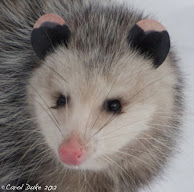While it is snowing out in my real world, I will turn back the pages of days, towards early spring and share another dear warbler that chooses to return each year to the gardens, fields and forest here. Every new spring day brings about more unfurling green and added bird songs . . . so much that it becomes like a symphony of warbles over the shrubs and trees and a challenge to single out and identify each one. It helps to catch a flash of color . . . a combination of marks that speak to a recognizable form. I can sometimes quickly recall a songbird, when seeing it flitter within the Viburnums or Hawthorne trees, such as the beautiful Yellow-rumped Warbler pictured here. The yellow markings are the most obvious clues.
One interesting fact about Yellow-rumped Warblers (Dendroica coronata) is that they have a unique ability to digest the waxy coated fruit of bayberries (Myrica spp..) This gastrointestinal trait allows them to expand their wintering sites along the shores in Massachusetts, perhaps into Maine and further north in much of these United States, than one would expect to ever see a warbler in winter. You may even see them at your suet feeders. Formerly known as Myrtle warblers, now I fear too often called merely 'Yellow-rump', they will spend all of autumn, winter and very early spring feasting on bayberries. During most of the spring and summer months they are seen gleaning trees and shrubs for insects.
Look carefully towards the center of the Viburnum. Do you see what I see?
Though too far away to get a crisp portrait, I love this pastel-like image of the little masked Yellow-rumped Warbler. His markings are so striking in the spring and summer months. The dotted dabs of yellow plumage join together to form a perfect triangle.
I wish I could insert a recording of the Yellow-rumped Warblers melodious trills right here.
 |
| Yellow-rumped Warbler |
This capture portrays a bit of a bandit feeling and you can see how the Yellow-rumped Warbler can at a glance, sometimes be mistaken as the beautiful Magnolia Warbler (Dendroica magnolia) below.
 |
| Magnolia Warbler |
 |
| Magnolia Warbler |
Yellow, black and white feathers are seen in both the masked Magnolia and Yellow-rumped Warblers, but they are fashioned together, so to speak, in quite different ways. The stroke of white above and below the masked eyes can at first fool the observer. I am glad I had my camera nearby, when sighting this pretty male songbird, for it was the only time I have been lucky to catch a glimpse of a Magnolia Warbler.
There is more to come in tones of yellows in the continuing 'Bird Parade.'
Meanwhile . . .
Winter is still very much with us here in New England.
Robins, Cedar Waxwings and Chickadees are the only birds I have truly sighted today. I have not seen the Bluebirds or Titmice in a few days now.
It is a great escape from the snow and ice, to look back over spring and summer photographs, finding the images I am sharing throughout my Bird Series posts.













































































































































































